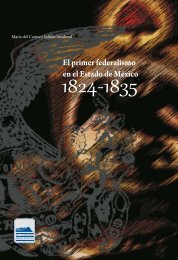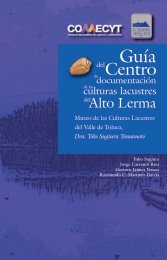You also want an ePaper? Increase the reach of your titles
YUMPU automatically turns print PDFs into web optimized ePapers that Google loves.
ERIC VAN YOUNG, THE SPHYNX OF SAN COSME: A HISTORIAN’S THOUGHTS ON WRITING A BIOGRAPHY<br />
650,000 words long. The publisher, Yale University<br />
Press, asked that I cut it down to 350,000<br />
words, or almost in half. Publication of the entire<br />
original work would have entailed two volumes,<br />
each of 600 or so pages. The publication costs<br />
and the sale price of such a work would have<br />
been prohibitive and the market correspondingly<br />
reduced (not that it was likely to be a bestseller,<br />
anyway), especially for a scholarly work<br />
on a Mexican statesman whom writers outside<br />
Mexico, Mexican historians, and the educated<br />
Mexican reading public, are unlikely ever to have<br />
heard of. I believe the final published version of<br />
the book holds up well, but I also believe that<br />
the book is considerably impoverished by the<br />
cuts I felt it necessary to make, precisely the<br />
deletion of revelatory details about his life. One<br />
example among many is the fascinating episode<br />
in which the twenty-year-old Alamán embroiled<br />
himself in a controversy in the capital’s Diario de<br />
México in 1812-1813 with the much older Fermín<br />
de Reygadas, a well-known mining engineer, astronomer,<br />
and ardent pro-royalist pamphleteer.<br />
The young Alamán heaped scorn on Reygadas’s<br />
attempt to refute Copernican theory in favor of<br />
an antiquated geocentric model of the solar system,<br />
causing sparks to fly for two or three issues<br />
of the journal. I devoted some pages to this<br />
episode in my manuscript, but scarcely a dozen<br />
lines in the book. The incident demonstrated the<br />
young man’s burgeoning scientific culture in his<br />
command of Copernican theory, his precocity,<br />
and his intellectual combativeness —hardly insignificant<br />
details, and a foreshadowing of his<br />
style when fully mature.<br />
Abundant details about minor aspects of a<br />
biographee’s life give one a picture of how people<br />
notable for their political, cultural, or other<br />
accomplishments lived their lives on a daily<br />
basis, providing biographers and their readers<br />
a 360-degree picture of how they fit into the<br />
world and satisfying our natural curiosity about<br />
how great (or even humble) people live. Information<br />
about how such individuals carried on<br />
their domestic lives, for instance, helps to round<br />
out the image of their public lives and may suggest<br />
interactions and contradictions between<br />
what they do in private, when in robe de chambre,<br />
and when in armadura ó peluca blonda.<br />
Where the subject’s interior life is concerned,<br />
it would be a rare case (except perhaps in the<br />
arts) in which public words or actions take on a<br />
confessional nature, whereas the details of daily<br />
life and other “trivialities” may well be more revealing.<br />
Assuming the data are there, of course,<br />
the decision about how much detail to include in<br />
a biography depends upon the sort of study one<br />
hopes to produce.<br />
Conclusion<br />
All this basically boils down to the question of<br />
how to interpret a life. What does a life mean<br />
(again, “meaning” being a relational property) in<br />
terms of its significance to larger historical currents,<br />
its achievements according to the conventional<br />
standards of the subject’s times or our<br />
own, its connection to other people, and to the<br />
figure her/himself? Assuming we seek to be as<br />
objective as possible rather than settle a score,<br />
as William C. Bullitt is alleged to have done, or<br />
advance some other nefarious project, what criteria<br />
do we apply to evaluate our effort? The<br />
ways in which a life affects and is affected by<br />
larger historical currents may not be obvious,<br />
but since biographical subjects are often prominent<br />
people whose public life is more or less<br />
well-documented, as in Lucas Alamán’s case, this<br />
should be the easiest aspect to deal with. Nor<br />
are the achievements of a life necessarily clear<br />
immediately: often they are, or with the passage<br />
of time become so. Somewhat more difficult to<br />
ascertain is the quality of connections to other<br />
people. And still more difficult may be the uncovering<br />
of secrets the subject of the biography<br />
does not wish to reveal. My obligation to the<br />
truth of the biography, for example, would have<br />
included “outing” Lucas Alamán had I found evidence<br />
that he was a closeted gay man, or exposing<br />
him for having taken large bribes while in<br />
his ministries, or having been an abusive parent.<br />
The biographer thus becomes a snoop, and the<br />
subject of a biography has in a sense waived her<br />
or his right to privacy by being prominent and<br />
being dead.<br />
Finally, absent autobiography, memoirs, or<br />
a particularly self-revelatory body of personal<br />
correspondence, the meaning of a biographical<br />
subject’s life to himself is the hardest to get at,<br />
especially where the personality of the biographee<br />
is as opaque as Alamán’s. The recognizability<br />
to him of the portrait I paint, were he<br />
14



![bicentenario_1[V2]](https://img.yumpu.com/68677971/1/167x260/bicentenario-1v2.jpg?quality=85)
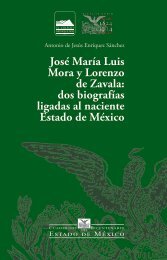


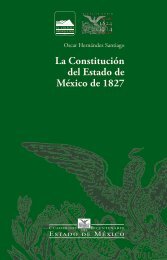
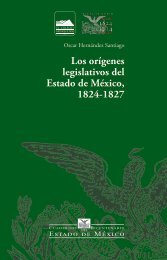
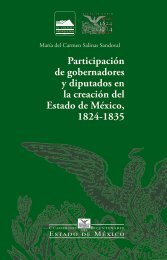
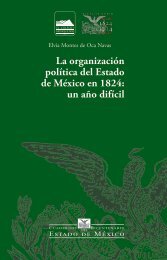
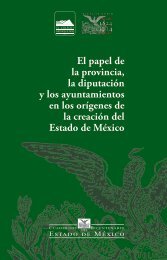
![El_primer_federalismoEM[final]_compressed (2)](https://img.yumpu.com/68483279/1/178x260/el-primer-federalismoemfinal-compressed-2.jpg?quality=85)
